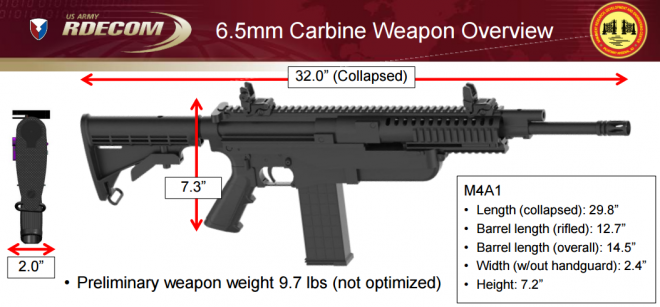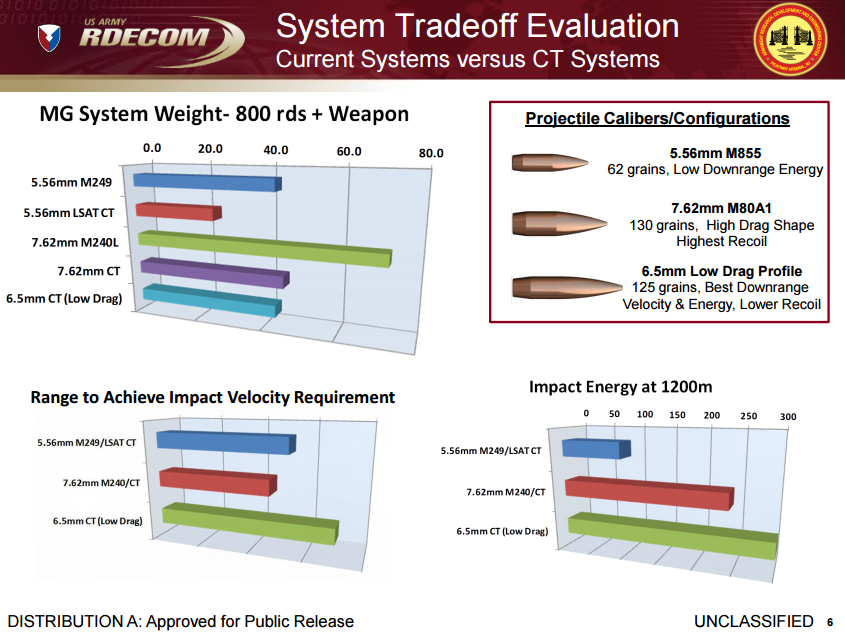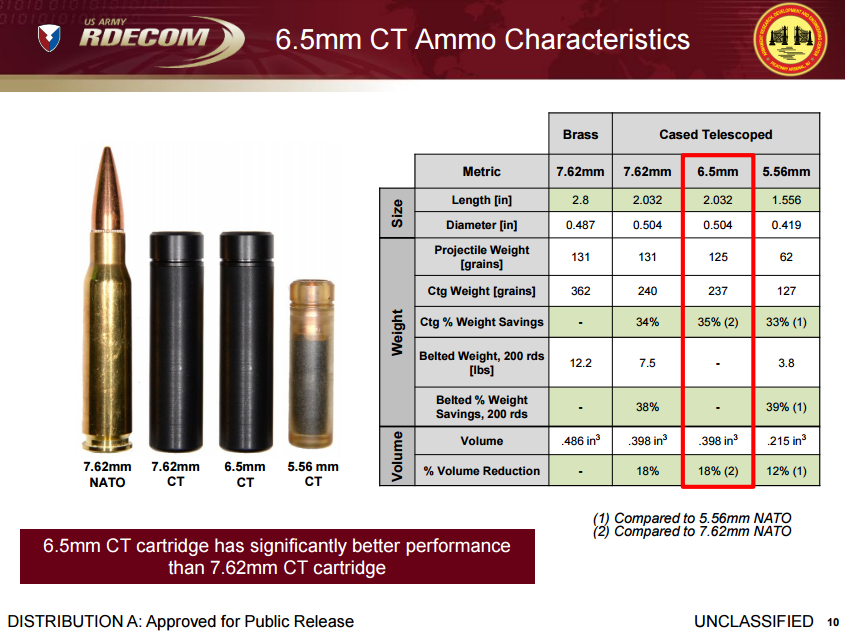The National Defense Industry Association has released the PowerPoint presentations from 2016 Armament Systems Forum, including Kori Phillips’ update on the Cased Telescoped Small Arms Systems (CTSAS) program, which is the successor to the well-known Lightweight Small Arms Technologies program (LSAT). Of special note in the presentation is the program’s decision to explore (and, to an extent, promote) the 6.5mm caliber as a viable option for CT configuration next-generation ammunition. There is quite a lot that could be discussed about this, but I’d like to focus on two pieces of information given to us by the presentation, those being the effective ranges and the weight cited for the 6.5mm CT ammunition, shown by the slides below:
Three things are evident from these slides: 1.) CTSAS seems to be seeking a 1200m effective range for the ammunition for both the support weapon and carbine (shown on slide 11), 2.) 6.5mm CT retains energy better, but is not significantly lighter than 7.62mm CT ammunition, and both are 30% heavier than even brass-cased 5.56mm, 3.) CTSAS has given up on the lethality and mobility increases cited by the LSAT program in 2014 as advantages of the lighter weight 5.56mm CT weapon versus the M249 (the 6.5mm and 7.62mm CT weapons and ammunition are both heavier than the M249 and its ammunition):
• Results for LSAT: – Squads employing the LSAT CT Light Machine Gun (LMG) [and M4A1+] had increases in lethality during short and long range engagements, improvements in speed of engagement and shot placement. – Soldiers attributed better mobility to the machine gun’s reduced size and weight in comparison to the current M249 – Weight and recoil reduction provide more precise fires on the objective particularly when AR gunners are firing from standing and kneeling positions – Automatic Riflemen were able to move quicker because of the lighter weight, with a positive impact on key AR missions
[emphasis mine]
I’ve read through most of the presentations from both last year’s NDIA conference and this one, and a trend has emerged: An emphasis on advanced, next-generation stabilized optics, lightweight cartridge cases, and small arms ammunition effective to 1200 meters or beyond. Whether these elements are connected into a single ambitious program or simply evidence of the “great minds think alike” phenomenon, I do not know, but if taken as a weathervane for future Army small arms development, they point to an overly ambitious set of requirements and goals for next generation small arms.
This is worrying, because what is clear to me is that the US Army has a long, sad history of creating programs that are far too ambitious, optimistic, and unrealistic relative to the actual needs of their forces in warfare. Worse, these programs have tended to collapse in a heap with no survivors, rather than be appropriately scaled back to produce spin-off products that see service. Just in small arms, we can point to the examples of the Objective Individual Combat Weapon, Advanced Combat Rifle, and Special Purpose Individual Weapon programs, all of which failed to produce hardly any resulting products at all. Even the M14, which was a successful program, was likewise initially based around requirements that were the product of vision-driven but unrealistic and overly optimistic thinking, and which over many years devolved into a procurement fiasco that took far more time and money than it should, and delivered a product that was in the end extremely underwhelming and virtually obsolete the day it was first issued.
I am extremely concerned by the hints that have come down the grapevine to me that the US Army development and procurement arms have now become obsessed with a 1200m capable individual weapon, which will it seems be justified by future technologies such as passively stabilized individual weapon systems and other speculative developments. The focus on a hypothetical but much-hyped long range engagement centering around each individual infantryman achieving “overmatch” versus enemy 7.62x54mmR medium/general purpose machine guns, while not a complete fantasy, doesn’t seem to reflect the realities of modern combined arms warfare, and seems to point towards the US Army seeking a procurement solution to what may well be an organizational problem. This is extremely worrying to someone like myself who is familiar with the skill set of the common individual, and who is very aware of the difficulty of long-range shooting under even ideal conditions. Expecting every soldier to take advantage of weapons designed to “overmatch” enemy weapons out to these extreme distances is an attitude that would take a considerable weight of empirical evidence to prove as valid and realistic.
It would of course be wonderful to equip our infantrymen with weapons with which they could engage and eliminate the enemy at distances beyond which the enemy may engage them in return, but if this vision is proven to be fantasy rather than possibility, all that these Army development programs will have accomplished – if we’re lucky – is fielding a weapon and ammunition that together are much larger and heavier than they need to be, and which will therefore have completely squandered the potential advantages of the lightweight cased ammunition concept. Given that the soldier’s load is already at a critical point, where fighting men are being taxed to their limit in service and then routinely returning to civilian life with high disability ratings, this is a mistake that the Army can ill afford.
Beyond the potential for tragic success, though, the history of US Army programs strongly suggests that a likely eventuality for over-ambitious Army infantry weapons development is “Total Program Kill”, where all efforts to develop a new system collapse in a heap due to management betting everything on advanced technologies that never materialize, taking with them all of the good ideas that were piggybacked on the program, and leaving the infantryman with the same weapon his fathers and grandfathers fought with, or one little or no better.
 Your Privacy Choices
Your Privacy Choices


